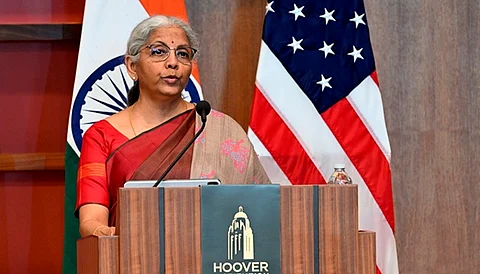
- News Updates
- PSU Watch
- Defence News
- Policy Watch
- हिन्दी न्यूज़
- Jobs Watch
- States News
- Event News

San Francisco: Finance Minister Nirmala Sitharaman on Monday said India plans to increase the share of the manufacturing sector from 12 per cent to 23 per cent over the next two decades, aiming to create jobs and drive economic growth.
India is focussing on 14 identified sunrise sectors like semiconductors, renewable energy components, medical devices, batteries and labour intensive industries, including leather and textile, to enhance the share of manufacturing in GDP, she said while speaking at Hoover Institution at Stanford University California.
For India, she said, "scaling up manufacturing is essential to absorb a youthful workforce, reduce import dependencies and build competitive global supply chains".
Observing that the world is undergoing a complete reset with regard to manufacturing in the view of industrial revolution 4.0, she said, India, too, is witnessing changes.
"In India's GDP, the service sector's contribution is about 64 per cent and if that is one side, at the lower end, the gig economy's growth is rapid. In fact, if 7.1 million people are in the gig economy today, as of 2021-22 data, we expect that to go to 230 million by 2030. That's not manufacturing," she said.
"So the service sector disproportionately contributes both to the GDP and to employment… but that's not to say manufacturing should be left aside. We have been hoping to increase the contribution of manufacturing from 12 per cent to about 22-23 per cent," she said, replying to a question as to what share of jobs the manufacturing sector will account for in the next decade, or by 2047.
The government has identified 14 sunrise sectors -- semiconductors, renewable energy components, medical devices, hydrogen mission, batteries and so on in order to strengthen manufacturing and introduced the production-linked incentive (PLI) scheme to promote them.
PLI is being offered to sectors that also have greater employment potential like electronic goods and similarly labour intensive sectors like textile and leather.
Highlighting the importance of manufacturing sector, she said, it binds societies and lends cohesion to communities by providing employment opportunities and financial strength to communities.
For long-term growth, she said, manufacturing emerges as a key engine for transformation.
"Manufacturing has historically been a cornerstone of the economic transformation of nations from 19th century Britain to 21st century East Asia. It creates a forward and backward linkages, catalyses skilling and pushes demand for infrastructure and governance reforms," she said.
On the recent tariff-related actions by the Trump administration in the US and its impact on India, Sitharaman said when there is stability in government, consistency in policy, a predictability in tax regime, investments and growth can be planned and executed to a large extent.
(PSU Watch– India's Business News centre that places the spotlight on PSUs, Bureaucracy, Defence and Public Policy is now on Google News. Click here to follow. Also, join PSU Watch Channel in your Telegram. You may also follow us on Twitter here and stay updated.)
